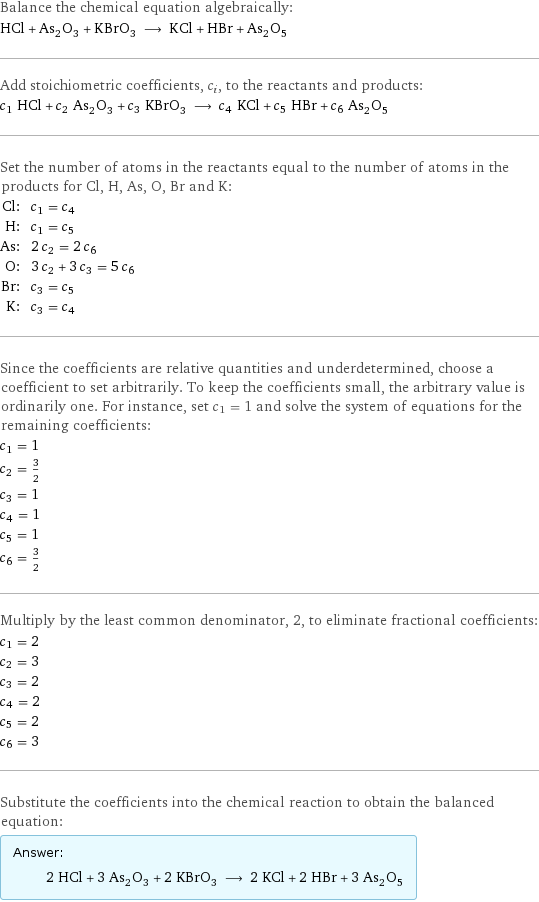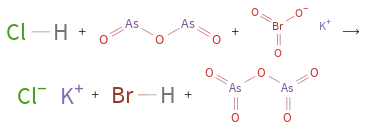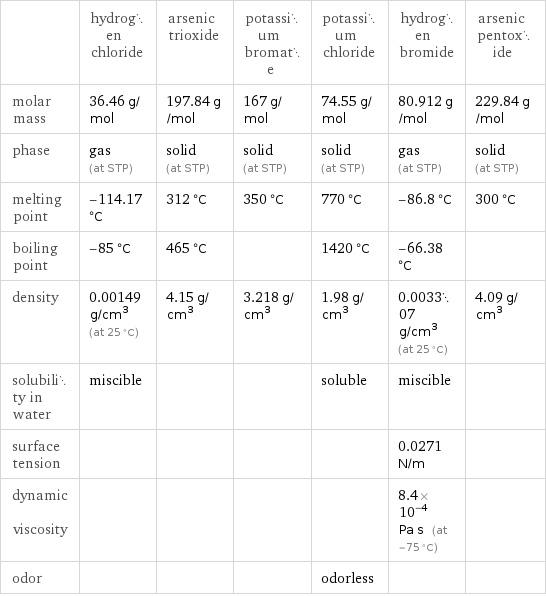Input interpretation

HCl hydrogen chloride + As_2O_3 arsenic trioxide + KBrO_3 potassium bromate ⟶ KCl potassium chloride + HBr hydrogen bromide + As_2O_5 arsenic pentoxide
Balanced equation

Balance the chemical equation algebraically: HCl + As_2O_3 + KBrO_3 ⟶ KCl + HBr + As_2O_5 Add stoichiometric coefficients, c_i, to the reactants and products: c_1 HCl + c_2 As_2O_3 + c_3 KBrO_3 ⟶ c_4 KCl + c_5 HBr + c_6 As_2O_5 Set the number of atoms in the reactants equal to the number of atoms in the products for Cl, H, As, O, Br and K: Cl: | c_1 = c_4 H: | c_1 = c_5 As: | 2 c_2 = 2 c_6 O: | 3 c_2 + 3 c_3 = 5 c_6 Br: | c_3 = c_5 K: | c_3 = c_4 Since the coefficients are relative quantities and underdetermined, choose a coefficient to set arbitrarily. To keep the coefficients small, the arbitrary value is ordinarily one. For instance, set c_1 = 1 and solve the system of equations for the remaining coefficients: c_1 = 1 c_2 = 3/2 c_3 = 1 c_4 = 1 c_5 = 1 c_6 = 3/2 Multiply by the least common denominator, 2, to eliminate fractional coefficients: c_1 = 2 c_2 = 3 c_3 = 2 c_4 = 2 c_5 = 2 c_6 = 3 Substitute the coefficients into the chemical reaction to obtain the balanced equation: Answer: | | 2 HCl + 3 As_2O_3 + 2 KBrO_3 ⟶ 2 KCl + 2 HBr + 3 As_2O_5
Structures

+ + ⟶ + +
Names

hydrogen chloride + arsenic trioxide + potassium bromate ⟶ potassium chloride + hydrogen bromide + arsenic pentoxide
Equilibrium constant
![Construct the equilibrium constant, K, expression for: HCl + As_2O_3 + KBrO_3 ⟶ KCl + HBr + As_2O_5 Plan: • Balance the chemical equation. • Determine the stoichiometric numbers. • Assemble the activity expression for each chemical species. • Use the activity expressions to build the equilibrium constant expression. Write the balanced chemical equation: 2 HCl + 3 As_2O_3 + 2 KBrO_3 ⟶ 2 KCl + 2 HBr + 3 As_2O_5 Assign stoichiometric numbers, ν_i, using the stoichiometric coefficients, c_i, from the balanced chemical equation in the following manner: ν_i = -c_i for reactants and ν_i = c_i for products: chemical species | c_i | ν_i HCl | 2 | -2 As_2O_3 | 3 | -3 KBrO_3 | 2 | -2 KCl | 2 | 2 HBr | 2 | 2 As_2O_5 | 3 | 3 Assemble the activity expressions accounting for the state of matter and ν_i: chemical species | c_i | ν_i | activity expression HCl | 2 | -2 | ([HCl])^(-2) As_2O_3 | 3 | -3 | ([As2O3])^(-3) KBrO_3 | 2 | -2 | ([KBrO3])^(-2) KCl | 2 | 2 | ([KCl])^2 HBr | 2 | 2 | ([HBr])^2 As_2O_5 | 3 | 3 | ([As2O5])^3 The equilibrium constant symbol in the concentration basis is: K_c Mulitply the activity expressions to arrive at the K_c expression: Answer: | | K_c = ([HCl])^(-2) ([As2O3])^(-3) ([KBrO3])^(-2) ([KCl])^2 ([HBr])^2 ([As2O5])^3 = (([KCl])^2 ([HBr])^2 ([As2O5])^3)/(([HCl])^2 ([As2O3])^3 ([KBrO3])^2)](../image_source/21339696f9b5e4b29fa2ec9bb7114575.png)
Construct the equilibrium constant, K, expression for: HCl + As_2O_3 + KBrO_3 ⟶ KCl + HBr + As_2O_5 Plan: • Balance the chemical equation. • Determine the stoichiometric numbers. • Assemble the activity expression for each chemical species. • Use the activity expressions to build the equilibrium constant expression. Write the balanced chemical equation: 2 HCl + 3 As_2O_3 + 2 KBrO_3 ⟶ 2 KCl + 2 HBr + 3 As_2O_5 Assign stoichiometric numbers, ν_i, using the stoichiometric coefficients, c_i, from the balanced chemical equation in the following manner: ν_i = -c_i for reactants and ν_i = c_i for products: chemical species | c_i | ν_i HCl | 2 | -2 As_2O_3 | 3 | -3 KBrO_3 | 2 | -2 KCl | 2 | 2 HBr | 2 | 2 As_2O_5 | 3 | 3 Assemble the activity expressions accounting for the state of matter and ν_i: chemical species | c_i | ν_i | activity expression HCl | 2 | -2 | ([HCl])^(-2) As_2O_3 | 3 | -3 | ([As2O3])^(-3) KBrO_3 | 2 | -2 | ([KBrO3])^(-2) KCl | 2 | 2 | ([KCl])^2 HBr | 2 | 2 | ([HBr])^2 As_2O_5 | 3 | 3 | ([As2O5])^3 The equilibrium constant symbol in the concentration basis is: K_c Mulitply the activity expressions to arrive at the K_c expression: Answer: | | K_c = ([HCl])^(-2) ([As2O3])^(-3) ([KBrO3])^(-2) ([KCl])^2 ([HBr])^2 ([As2O5])^3 = (([KCl])^2 ([HBr])^2 ([As2O5])^3)/(([HCl])^2 ([As2O3])^3 ([KBrO3])^2)
Rate of reaction
![Construct the rate of reaction expression for: HCl + As_2O_3 + KBrO_3 ⟶ KCl + HBr + As_2O_5 Plan: • Balance the chemical equation. • Determine the stoichiometric numbers. • Assemble the rate term for each chemical species. • Write the rate of reaction expression. Write the balanced chemical equation: 2 HCl + 3 As_2O_3 + 2 KBrO_3 ⟶ 2 KCl + 2 HBr + 3 As_2O_5 Assign stoichiometric numbers, ν_i, using the stoichiometric coefficients, c_i, from the balanced chemical equation in the following manner: ν_i = -c_i for reactants and ν_i = c_i for products: chemical species | c_i | ν_i HCl | 2 | -2 As_2O_3 | 3 | -3 KBrO_3 | 2 | -2 KCl | 2 | 2 HBr | 2 | 2 As_2O_5 | 3 | 3 The rate term for each chemical species, B_i, is 1/ν_i(Δ[B_i])/(Δt) where [B_i] is the amount concentration and t is time: chemical species | c_i | ν_i | rate term HCl | 2 | -2 | -1/2 (Δ[HCl])/(Δt) As_2O_3 | 3 | -3 | -1/3 (Δ[As2O3])/(Δt) KBrO_3 | 2 | -2 | -1/2 (Δ[KBrO3])/(Δt) KCl | 2 | 2 | 1/2 (Δ[KCl])/(Δt) HBr | 2 | 2 | 1/2 (Δ[HBr])/(Δt) As_2O_5 | 3 | 3 | 1/3 (Δ[As2O5])/(Δt) (for infinitesimal rate of change, replace Δ with d) Set the rate terms equal to each other to arrive at the rate expression: Answer: | | rate = -1/2 (Δ[HCl])/(Δt) = -1/3 (Δ[As2O3])/(Δt) = -1/2 (Δ[KBrO3])/(Δt) = 1/2 (Δ[KCl])/(Δt) = 1/2 (Δ[HBr])/(Δt) = 1/3 (Δ[As2O5])/(Δt) (assuming constant volume and no accumulation of intermediates or side products)](../image_source/17046407b16af9dd803e3bcf1c8c0df2.png)
Construct the rate of reaction expression for: HCl + As_2O_3 + KBrO_3 ⟶ KCl + HBr + As_2O_5 Plan: • Balance the chemical equation. • Determine the stoichiometric numbers. • Assemble the rate term for each chemical species. • Write the rate of reaction expression. Write the balanced chemical equation: 2 HCl + 3 As_2O_3 + 2 KBrO_3 ⟶ 2 KCl + 2 HBr + 3 As_2O_5 Assign stoichiometric numbers, ν_i, using the stoichiometric coefficients, c_i, from the balanced chemical equation in the following manner: ν_i = -c_i for reactants and ν_i = c_i for products: chemical species | c_i | ν_i HCl | 2 | -2 As_2O_3 | 3 | -3 KBrO_3 | 2 | -2 KCl | 2 | 2 HBr | 2 | 2 As_2O_5 | 3 | 3 The rate term for each chemical species, B_i, is 1/ν_i(Δ[B_i])/(Δt) where [B_i] is the amount concentration and t is time: chemical species | c_i | ν_i | rate term HCl | 2 | -2 | -1/2 (Δ[HCl])/(Δt) As_2O_3 | 3 | -3 | -1/3 (Δ[As2O3])/(Δt) KBrO_3 | 2 | -2 | -1/2 (Δ[KBrO3])/(Δt) KCl | 2 | 2 | 1/2 (Δ[KCl])/(Δt) HBr | 2 | 2 | 1/2 (Δ[HBr])/(Δt) As_2O_5 | 3 | 3 | 1/3 (Δ[As2O5])/(Δt) (for infinitesimal rate of change, replace Δ with d) Set the rate terms equal to each other to arrive at the rate expression: Answer: | | rate = -1/2 (Δ[HCl])/(Δt) = -1/3 (Δ[As2O3])/(Δt) = -1/2 (Δ[KBrO3])/(Δt) = 1/2 (Δ[KCl])/(Δt) = 1/2 (Δ[HBr])/(Δt) = 1/3 (Δ[As2O5])/(Δt) (assuming constant volume and no accumulation of intermediates or side products)
Chemical names and formulas
![| hydrogen chloride | arsenic trioxide | potassium bromate | potassium chloride | hydrogen bromide | arsenic pentoxide formula | HCl | As_2O_3 | KBrO_3 | KCl | HBr | As_2O_5 Hill formula | ClH | As_2O_3 | BrKO_3 | ClK | BrH | As_2O_5 name | hydrogen chloride | arsenic trioxide | potassium bromate | potassium chloride | hydrogen bromide | arsenic pentoxide IUPAC name | hydrogen chloride | 2, 4, 5-trioxa-1, 3-diarsabicyclo[1.1.1]pentane | potassium bromate | potassium chloride | hydrogen bromide |](../image_source/9f9c9c05528485fce85278ff09d08144.png)
| hydrogen chloride | arsenic trioxide | potassium bromate | potassium chloride | hydrogen bromide | arsenic pentoxide formula | HCl | As_2O_3 | KBrO_3 | KCl | HBr | As_2O_5 Hill formula | ClH | As_2O_3 | BrKO_3 | ClK | BrH | As_2O_5 name | hydrogen chloride | arsenic trioxide | potassium bromate | potassium chloride | hydrogen bromide | arsenic pentoxide IUPAC name | hydrogen chloride | 2, 4, 5-trioxa-1, 3-diarsabicyclo[1.1.1]pentane | potassium bromate | potassium chloride | hydrogen bromide |
Substance properties

| hydrogen chloride | arsenic trioxide | potassium bromate | potassium chloride | hydrogen bromide | arsenic pentoxide molar mass | 36.46 g/mol | 197.84 g/mol | 167 g/mol | 74.55 g/mol | 80.912 g/mol | 229.84 g/mol phase | gas (at STP) | solid (at STP) | solid (at STP) | solid (at STP) | gas (at STP) | solid (at STP) melting point | -114.17 °C | 312 °C | 350 °C | 770 °C | -86.8 °C | 300 °C boiling point | -85 °C | 465 °C | | 1420 °C | -66.38 °C | density | 0.00149 g/cm^3 (at 25 °C) | 4.15 g/cm^3 | 3.218 g/cm^3 | 1.98 g/cm^3 | 0.003307 g/cm^3 (at 25 °C) | 4.09 g/cm^3 solubility in water | miscible | | | soluble | miscible | surface tension | | | | | 0.0271 N/m | dynamic viscosity | | | | | 8.4×10^-4 Pa s (at -75 °C) | odor | | | | odorless | |
Units
